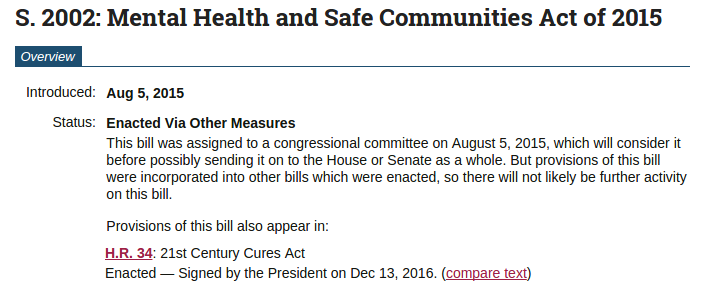A new analysis we incorporated into GovTrack late last year reveals when provisions of bills are incorporated into other bills. Our new tool will reveal much more about what Congress is doing, and what laws are being made, than has ever been known to the general public.
For the complete post, please read about our data analysis here.
All too often Congress cuts bills apart and pastes them back together—sometimes into an “omnibus.” The bills that finally get a vote are an amalgam of provisions from other bills that either can’t or won’t get a standalone vote themselves. The most important legislation is crafted this way.
Seeing the network of bills that eventually become law is crucial for understanding how legislative process works. It is a crucial way the majority and minority parties in Congress work together. Without looking at the network, Congress may appear far more partisan than it really is. And without knowing how Congress works, outsiders can’t hope to be effective participants in our own government.
Only about 3% of bills will be enacted through the signature of the President or a veto override. Another 1% are identical to those bills, so-called “companion bills,” which are easily identified. Our new analysis reveals almost another 3% of bills which had substantial parts incorporated into an enacted bill in 2015–2016. To miss that last 3% is to be practically 100% wrong about how many bills are being enacted by Congress.
What to look for on GovTrack
Bill status now reflects text incorporation
We’ll show show two new statuses for bills when their provisions have been incorporated into enacted bills.
The first is “Enacted Via Other Measures,” which we’ll show when a bill has at least about 33% of its provisions incorporated into one or more enacted bills, and we’ll link to the bills its provisions were incorporated into:
We’ll say “Parts Incorporated Into Other Measures” when a bill has some of its text, but less than about 33%, in common with enacted bills.
The flip side: Tracing enacted laws back to their sources.
We’ll also show the same information, but from the opposite perspective, on the pages for enacted bills. When an enacted bill has text in common with other bills, we’ll show all of those other bills in a new section called “Incorporated Legislation”:
In both cases, “compare text” links take you to a comparison of the text of the two bills (a feature we’ve long had).
In bill search
Our advanced search has been updated to allow you to find all bills that we consider enacted, either the real way (signed by the President, etc.) or by what we now call “enacted via other measures” (see above). Turn on theEnacted?—?Including by Incorporation into Other Bills filter to see them all.

This is particularly useful when you want to see what laws a particular Member of Congress had a leading role in getting enacted. You’ll want to count not only the enacted bills that had their name on it but also ones that weren’t enacted but had significant provisions moved into bills that were. The Enacted?—?Including by Incorporation into Other Billsfilter does just that.
(This filter replaces an earlier filter called “Enacted?—?Including via Companion Bills” which performed the same function but only included bills identified by the CRS as totally identical (see below). The new functionality goes beyond identical.)
Legislator pages now list recent enacted bills
Now that we can identify all of the bills that were “enacted” by a legislator, including via text incorporation, we are able to show that on our legislator pages. Here’s the new Enacted Legislation section on the page for Sen. Steve Daines, showing a bill that had a major component incorporated into two other bills that were enacted:

The laws enacted part of our legislator report cards, which show key legislative statistics for each legislator, now include bills enacted via text incorporation rather than just bills enacted the usual way.



You must be logged in to post a comment.